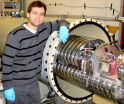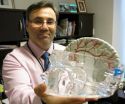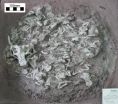(Press-News.org) The field of astrophysics has a stubborn problem and it's called lithium. The quantities of lithium predicted to have resulted from the Big Bang are not actually present in stars. But the calculations are correct – a fact which has now been confirmed for the first time in experiments conducted at the underground laboratory in the Gran Sasso mountain in Italy. As part of an international team, researchers from the Helmholtz-Zentrum Dresden-Rossendorf (HZDR) studied how much lithium forms under Big Bang conditions. The results were published in "Physical Review Letters".
Lithium, aside from hydrogen and helium, is one of the three elements that are created before the first stars form. These three elements were – according to the theory – already created early on, through what is known as "primordial nucleosynthesis." That means that when the universe was only a few minutes old, neutrons and protons merged to form the nuclei of the these elements. At the Laboratory for Underground Nuclear Astrophysics (LUNA), the nucleosynthesis of lithium has now been reproduced by an international team of scientists. Michael Anders, who earned his doctorate in the last year at TU Dresden and HZDR on this very topic, took a leading role on the team. Within the framework of a project that was funded by the German Research Foundation, he was supervised by Dr. Daniel Bemmerer, group leader at HZDR.
In the Italian underground laboratory, the scientists fired helium nuclei at heavy hydrogen (known as deuterium) in order to reach energies similar to those just after the Big Bang. The idea was to measure how much lithium forms under similar conditions to those during the early stages of the universe. The result of the experiment: the data confirmed the theoretical predictions, which are incompatible with the observed lithium concentrations found in the universe.
"For the first time, we could actually study the lithium-6 production in one part of the Big Bang energy range with our experiment," explains Daniel Bemmerer. Lithium-6 (three neutrons, three protons) is one of the element's two stable isotopes. The formation of lithium-7, which possesses an additional neutron, was studied in 2006 by Bemmerer at LUNA.
With these new results, what is known as the "lithium problem" remains a hard nut to crack: on the one hand, now all laboratory results of the astrophysicists suggest that the theory of primordial nucleosynthesis is correct. On the other hand, many observations of astronomers show that the oldest stars in our Milky Way contain only half as much lithium-7 as predicted. Sensational reports by Swedish researchers, who discovered clearly more lithium-6 in such stars than predicted, must also likely be checked again based on the new LUNA data. Bemmerer says, "Should unusual lithium concentrations be observed in the future, we know, thanks to the new measurements, that it cannot be due to the primordial nucleosynthesis."
Further research will soon be carried out in a new underground laboratory in Dresden
What was important for the studies was the special location of LUNA: in the mountainous Gran Sasso d'Italia, 1400 meters of solid rock keep the disturbance from cosmic radiation at bay. The experimental setup is additionally enveloped in a lead shell. Only with such good shielding can the rare interactions between the nuclei be precisely determined. But within the next year, similar research will also be possible in Dresden. TU Dresden and HZDR will put the accelerator laboratory "Felsenkeller" into operation. Although the solid rock shielding from natural radiation in this former brewery cellar is only forty-five meters, it is already sufficient for many measurements. The new laboratory also possesses a particle accelerator that is more than twelve times as strong: "There we can expand our experiments and study the formation of elements at high energy ranges", says Bemmerer.
INFORMATION:
Measurement at Big Bang conditions confirms lithium problem
New experimental data confirm lithium nucleosynthesis after Big Bang
2014-08-27
ELSE PRESS RELEASES FROM THIS DATE:
Gamblers are greedy bird-brains, University of Warwick research finds
2014-08-27
Gamblers are greedy bird-brains, University of Warwick research finds
Gamblers show the same tendencies as pigeons when they make risky decisions, new research has shown.
Researchers, led by Dr Elliot Ludvig of the University of Warwick's Department of Psychology, conducted tests that found that both human gamblers and pigeons were 35% more likely to gamble for high-value than low-value rewards.
Published in Biology Letters, the researchers argue that the test results show the important role that memories of previous biggest wins and losses play when we make risky ...
The thunder god vine, assisted by nanotechnology, could shake up future cancer treatment
2014-08-27
Hepatocellular carcinoma (HCC) is the second leading cause of cancer-associated death worldwide. These regrettably poor prognoses are due to the difficulty in treating this cancer using conventional chemotherapeutic drugs such as doxorubicin, epirubicin, cisplatin, 5-fluorouracil, etoposide or combinations therein. This may be attributed to that the conventional medicines are not able to reach in a sufficient concentration in the liver tumor cells at levels that are not harmful to the rest of the body. Considering the large percentage of patients that are deemed ineligible ...
DTU researchers film protein quake for the first time
2014-08-27
One of nature's mysteries is how plants survive impact by the huge amounts of energy contained in the sun's rays, while using this energy for photosynthesis. The hypothesis is that the light-absorbing proteins in the plant's blades quickly dissipate the energy throughout the entire protein molecule through so-called protein quakes. Researchers at DTU Physics have now managed to successfully 'film' this process.
Both plants, algae and bacteria contain light-absorbing proteins which play a role in photosynthesis and thus how the organisms produce energy. However, it has ...
A prescription for better stroke care
2014-08-27
TORONTO, Aug. 27, 2014 – Stroke patients are 70 per cent more likely to continue taking their stroke prevention medications one year later if they have a prescription in hand when discharged – according to researchers at St. Michael's Hospital and the Institute for Clinical Evaluative Sciences (ICES).
Using data from 11 stroke centres, researchers determined how many Ontarians were taking their medications one week, one year and two years after having a stroke. The results reveal the importance of simple interventions, such as giving a prescription to a patient before ...
The roots of human altruism
2014-08-27
VIDEO:
Sakis play the group service game.
Click here for more information.
Scientists have long been searching for the factor that determines why humans often behave so selflessly. It was known that humans share this tendency with species of small Latin American primates of the family Callitrichidae (tamarins and marmosets), leading some to suggest that cooperative care for the young, which is ubiquitous in this family, was responsible for spontaneous helping behavior. But it ...
Fighting prostate cancer with a tomato-rich diet
2014-08-27
Men who eat over 10 portions a week of tomatoes have an 18 per cent lower risk of developing prostate cancer, new research suggests.
With 35,000 new cases every year in the UK, and around 10,000 deaths, prostate cancer is the second most common cancer in men worldwide.
Rates are higher in developed countries, which some experts believe is linked to a Westernised diet and lifestyle.
To assess if following dietary and lifestyle recommendations reduces risk of prostate cancer, researchers at the Universities of Bristol, Cambridge and Oxford looked at the diets and lifestyle ...
Leading scientists call for a stop to non-essential use of fluorochemicals
2014-08-27
Fluorochemicals are synthetically produced chemicals, which repel water and oil and are persistent towards aggressive physical and chemical conditions in industrial processing. These characteristics have made the fluorochemicals useful in numerous processes and products, such as coatings for food paper and board.
The problem with fluorochemicals is that they are difficult to break down and accumulate in both humans and the environment. Some fluorochemicals have known correlations with harmful health effects, such as cancer, increased cholesterol and a weaker immune system ...
Penn paleontologists describe a possible dinosaur nest and young 'babysitter'
2014-08-27
Dinosaurs are often depicted as giant, frightening beasts. But every creature is a baby once.
A new examination of a rock slab containing fossils of 24 very young dinosaurs and one older individual is suggestive of a group of hatchlings overseen by a caretaker, according to a new study by University of Pennsylvania researchers.
Penn's Brandon P. Hedrick and Peter Dodson led the work, collaborating with researchers from China's Dalian Museum of Natural History, where the specimen is held. Hedrick is a doctoral student in the School of Arts & Sciences' Department of Earth ...
Potential therapy for incurable Charcot-Marie-Tooth disease
2014-08-27
This news release is available in German.
Charcot-Marie-Tooth disease type 1A is the most common inherited disease affecting the peripheral nervous system. Researchers from the Department of Neurogenetics at the Max Planck Institute of Experimental Medicine and University Medical Centre Göttingen have discovered that the maturity of Schwann cells is impaired in rats with the disease. These cells enwrap the nerve fibres with an insulating layer known as myelin, which facilitates the rapid transfer of electrical impulses. If Schwann cells cannot mature correctly, ...
Potential therapy for the Sudan strain of Ebola could help contain some future outbreaks
2014-08-27
Ebola is a rare, but deadly disease that exists as five strains, none of which have approved therapies. One of the most lethal strains is the Sudan ebolavirus (SUDV). Although not the strain currently devastating West Africa, SUDV has caused widespread illness, even as recently as 2012. In a new study appearing in the journal ACS Chemical Biology, researchers now report a possible therapy that could someday help treat patients infected with SUDV.
John Dye, Sachdev Sidhu, Jonathan Lai and colleagues explain that about 50-90 percent of ebola patients die after experiencing ...
LAST 30 PRESS RELEASES:
First Editorial of 2026: Resisting AI slop
Joint ground- and space-based observations reveal Saturn-mass rogue planet
Inheritable genetic variant offers protection against blood cancer risk and progression
Pigs settled Pacific islands alongside early human voyagers
A Coral reef’s daily pulse reshapes microbes in surrounding waters
EAST Tokamak experiments exceed plasma density limit, offering new approach to fusion ignition
Groundbreaking discovery reveals Africa’s oldest cremation pyre and complex ritual practices
First breathing ‘lung-on-chip’ developed using genetically identical cells
How people moved pigs across the Pacific
Interaction of climate change and human activity and its impact on plant diversity in Qinghai-Tibet plateau
From addressing uncertainty to national strategy: an interpretation of Professor Lim Siong Guan’s views
Clinical trials on AI language model use in digestive healthcare
Scientists improve robotic visual–inertial trajectory localization accuracy using cross-modal interaction and selection techniques
Correlation between cancer cachexia and immune-related adverse events in HCC
Human adipose tissue: a new source for functional organoids
Metro lines double as freight highways during off-peak hours, Beijing study shows
Biomedical functions and applications of nanomaterials in tumor diagnosis and treatment: perspectives from ophthalmic oncology
3D imaging unveils how passivation improves perovskite solar cell performance
Enriching framework Al sites in 8-membered rings of Cu-SSZ-39 zeolite to enhance low-temperature ammonia selective catalytic reduction performance
AI-powered RNA drug development: a new frontier in therapeutics
Decoupling the HOR enhancement on PtRu: Dynamically matching interfacial water to reaction coordinates
Sulfur isn’t poisonous when it synergistically acts with phosphine in olefins hydroformylation
URI researchers uncover molecular mechanisms behind speciation in corals
Chitin based carbon aerogel offers a cleaner way to store thermal energy
Tracing hidden sources of nitrate pollution in rapidly changing rural urban landscapes
Viruses on plastic pollution may quietly accelerate the spread of antibiotic resistance
Three UH Rainbow Babies & Children’s faculty elected to prestigious American Pediatric Society
Tunnel resilience models unveiled to aid post-earthquake recovery
Satellite communication systems: the future of 5G/6G connectivity
Space computing power networks: a new frontier for satellite technologies
[Press-News.org] Measurement at Big Bang conditions confirms lithium problemNew experimental data confirm lithium nucleosynthesis after Big Bang






